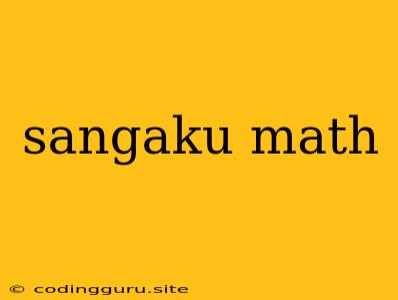The Beauty of Sangaku: Exploring the Art of Japanese Geometry
Sangaku, meaning "mathematical tablet" in Japanese, represents a fascinating intersection of art, geometry, and cultural history. These geometric problems, often inscribed on wooden tablets and displayed in temples and shrines across Japan, were a unique way for people to share their mathematical knowledge and challenge others with intricate geometric puzzles.
What are Sangaku problems?
At its core, Sangaku is about exploring the beauty of geometry through visual representation. These problems typically involve circles, triangles, squares, and other geometric shapes, often nested within each other or intersecting in complex ways. The challenge lies in finding relationships between these shapes, proving theorems, and calculating areas or lengths.
A Glimpse into the World of Sangaku Problems:
Imagine a circle inscribed within a square, with a smaller circle touching the inner circle and two sides of the square. The Sangaku problem might ask you to find the ratio of the radius of the smaller circle to the radius of the larger circle. The solution often involves clever use of geometric theorems like the Pythagorean theorem, the circle theorem, or even more advanced concepts.
Beyond the Puzzles: The Cultural Significance of Sangaku
Sangaku goes beyond just mathematical problems. They served as a way for people to express their appreciation for geometry, share their mathematical knowledge, and even challenge their peers. These tablets were often dedicated to deities, reflecting a belief in the power of mathematics and its connection to the divine.
How to Approach Sangaku Problems:
Solving Sangaku problems requires a combination of visual thinking, geometric understanding, and algebraic manipulation. Here are some tips:
- Visualize the problem: Start by carefully drawing the diagram of the problem. This helps you see the relationships between the different shapes involved.
- Identify relevant theorems: Look for ways to apply geometric theorems like the Pythagorean theorem, the circle theorem, or the angle bisector theorem.
- Break down the problem: Sometimes, the problem can be simplified by dividing it into smaller parts.
- Don't be afraid to experiment: Use different approaches and methods to find the solution.
- Share your findings: Discuss your solutions with others to gain new insights and perspectives.
Examples of Sangaku Problems:
- The Inscribed Circle Problem: A circle is inscribed within an equilateral triangle. Find the relationship between the radius of the circle and the side length of the triangle.
- The Four Circles Problem: Four circles are inscribed within a square, each touching two sides of the square and one other circle. Find the ratio of the radius of the smaller circles to the radius of the larger circle.
- The Nested Circles Problem: A circle is inscribed within an isosceles triangle, and another circle is inscribed within the smaller triangle formed by the base of the original triangle and the points of intersection of the first circle with the sides of the original triangle. Find the ratio of the radii of the two circles.
Conclusion
Sangaku problems offer a fascinating blend of mathematical exploration and cultural significance. They challenge us to think visually, apply our geometric knowledge, and appreciate the beauty of geometry. By delving into the world of Sangaku, we gain a unique perspective on the history of mathematics, the art of problem-solving, and the cultural values that shape our understanding of the world.
